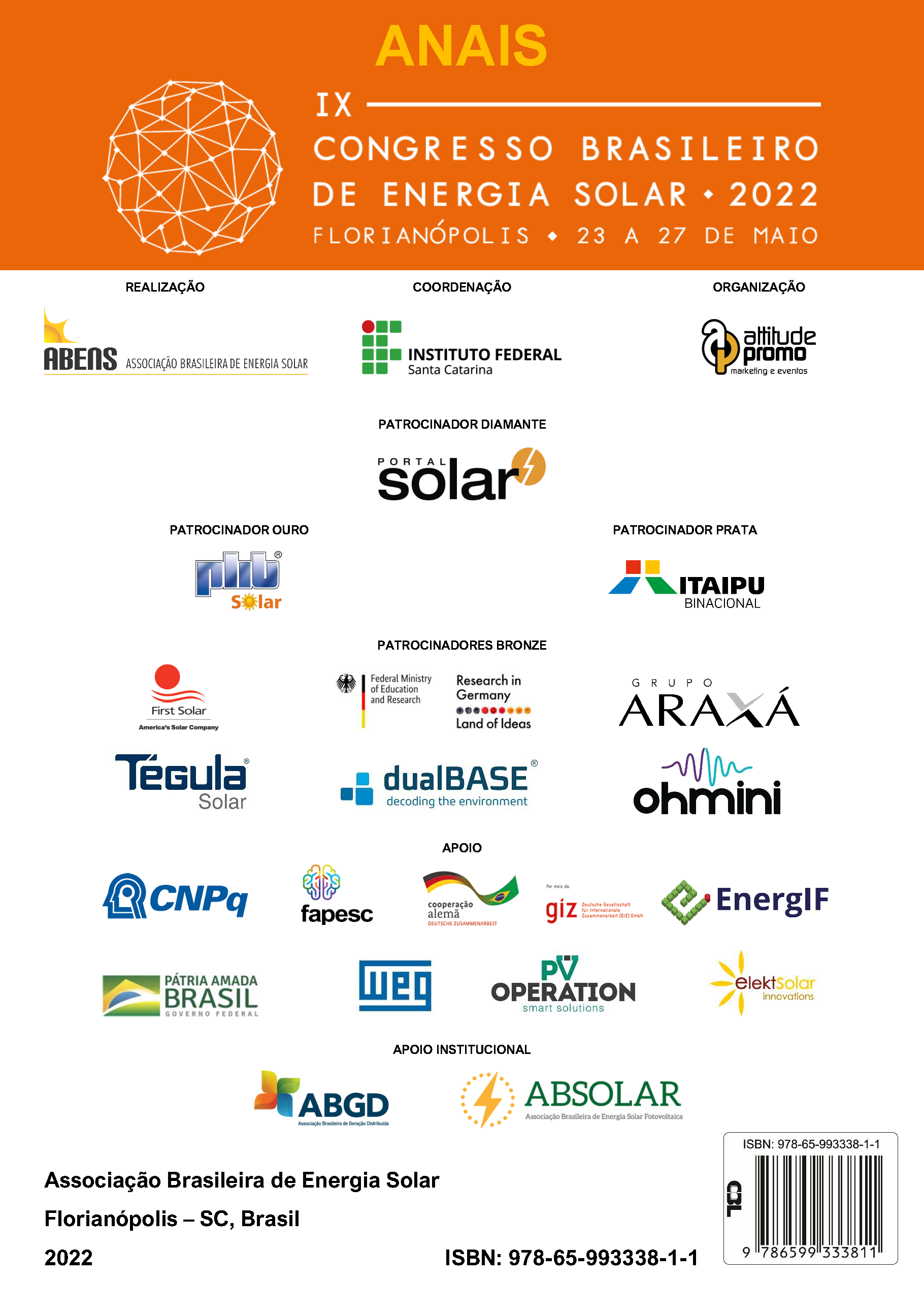METODOLOGIA DE DETERMINAÇÃO DO ALBEDO DO SOLO A PARTIR DO PROCESSAMENTO DE IMAGENS DIGITAIS
DOI:
https://doi.org/10.59627/cbens.2022.1224Palavras-chave:
Energia Solar, Albedo do Solo, Modelo PreditivoResumo
A fração da luz incidente, refletida por uma superfície é definida como sendo o seu albedo. Conhecer o albedo de uma determinada área é útil para estudos relacionados a projetos de usinas fotovoltaicas que utilizam módulos bifaciais. Ao contrário dos painéis convencionais, esses módulos são capazes de gerar eletricidade a partir das suas duas faces. Dentre as vantagens associadas ao seu uso, destaca-se o aumento da densidade energética. Alguns trabalhos recentes, evidenciam a forte relação que o albedo possui com o ganho energético proporcionado por painéis bifaciais. Conhecer a sazonalidade do albedo é de suma importância para os cálculos de previsão e precificação da energia gerada no projeto. As normativas vigentes recomendam que o albedo do solo seja mensurado utilizando piranômetros. Entretanto, o dispêndio com a aquisição e manutenção desses equipamentos acaba tornado a sua instalação muitas vezes inviável. Em virtude disso, o objetivo deste trabalho, foi avaliar a viabilidade de uma metodologia de baixo custo, para medição do albedo do solo. A metodologia usada sugere que o albedo do solo pode ser obtido a partir da análise do brilho das regiões de uma imagem contendo o solo e uma folha branca. Com o propósito de calcular a acurácia do método, foram realizadas coletas de imagens do solo na cidade de Petrolina-PE e comparadas com medições realizadas a partir de piranômetros modelo SR15-D2A2® (Hukseflux). Além disso, foi desenvolvido um script para o processamento em massa das imagens, bem como um modelo de ajuste utilizando o algoritmo Randon Forest, com R² > 0,99, que relaciona os dados obtidos, a partir do processamento das imagens, com valores medidos por um albedômetro composto por piranômetros da marca Hukseflux.
The fraction of incident light reflected by a surface is defined as its albedo. Knowing the albedo of a given area is useful for studies related to photovoltaic power plant projects that use biface modules. Unlike conventional panels, these modules are capable of generating electricity from their two sides. Among the advantages associated with its use, the increase in energy density stands out. Some recent works show the strong relationship that albedo has with the energy gain provided by bifacial panels. Knowing the seasonality of albedo is of paramount importance for forecasting and pricing calculations for the energy generated in the project. Current regulations recommend that soil albedo be measured using pyranometers. However, the expense with the acquisition and maintenance of these equipments ends up making its installation unfeasible. As a result, the objective of this work was to evaluate the feasibility of a low-cost methodology for measuring soil albedo. The methodology used suggests that the soil albedo can be obtained from the analysis of the brightness of the regions of an image containing the soil and a white sheet. In order to calculate the accuracy of the method, soil images were collected in the city of Petrolina-PE and compared with measurements using SR15-D2A2® (Hukseflux) pyranometers. In addition, a script for the mass processing of images was developed, as well as an adjustment model using the Randon Forest algorithm, with R² > 0.99, which relates the data obtained from image processing with measured values by an albedometer composed of Hukseflux brand pyranometers.
Downloads
Referências
BRENNAN, P. A. Medidas de albedo no Monte. Site de teste Lassen. Nevada Univ. Reno, NV, United States. NASA-CR-101794. , 1968.
CIERNIEWSKI, J. et al. Predicting the diurnal blue-sky albedo of soils using their laboratory reflectance spectra and roughness indices. Journal of Quantitative Spectroscopy and Radiative Transfer, Volume 200, p. 25-31, 2017.
DITTMANN, S. et al. Comparative Analysis of albedo measurements (Plane-of-array and horizontal) at multiple sites worldwide. 10.4229/EUPVSEC20192019-5DO.1.4. , 2019.
DELINE, C. et al. Bifacial PV System performance: separating fact from Fiction. Disponível
em: https://www.nrel.gov/docs/fy19osti/74090.pdf. Acesso em: 02 mar. 2021. Publicado em 2019.
American Society for Testing and Materials. E1918-06: Standard Teste Method for Measuring Solar Reflectance of Horizontal and Low-Sloped Surfaces in the Field. West Conshohocken, Pennsylvania, Estados Unidos, 2015.
International Organization for Standardization ISO 9847 :Solar energy — Calibration of field pyranometers by comparison to a reference pyranometer. Technical Committee ISO/TC 180, Solar energy, Sub-Committee SC 1, Climate — Measurement and data. 1992.
International Organization for Standardization ISO 9060: Solar energy -- Specification and classification of instruments for measuring hemispherical solar and direct solar radiation. Technical Committee ISO/TC 180, Solar energy, Subcommittee SC 1, Climate — Measurement and data. 2018.
MARION, B. Measured and satellite-derived albedo data for estimating bifacial photovoltaic system performance. Solar Energy, Volume 215, Pages 321-327, ISSN 0038-092X, https://doi.org/10.1016/j.solener.2020.12.050, 2021.
MORTON, S. Albedo Effects in Polar Regions. In: https://scholarworks.umass.edu/. 2012. Disponível em: https://scholarworks.umass.edu/stem_ipy/11/. Acesso em: 19 de mai. 2021.
POST et al. Predicting Soil Albedo from Soil Color and Spectral Reflectance Data. Soil Sci. Soc. Sou. J., 64: p. 1027-1034, 2000.
OATSU, N. A thresholding selection method from gray-level histograms. IEEE Trans System Man Cybernetic. 1979, pp. 62-66
SÁNCHEZ-ORTIZ et al. The effect of clearance height, albedo, tilt and azimuth angle in bifacial PV energy estimation using different existing algorithms. Escola de Engenharia Eletrônica, Instituto de Tecnologia da Costa Rica, Costa , 2020.
SILVA et al. Determinação do albedo de áreas irrigadas com base em imagens LANDSAT 5-TM. Rev. Bras. Agrometeorologia, v. 13, n.2, p. 11-21, 2005. ISSN 0104-1347
TAKATA, M. Tecnologias de módulos e células fotovoltaicas. Agência Canal Energia. Rio de Janeiro, out. 2019. Agência Canal Energia. Rio de Janeiro, out. 2019. Disponível em <https://bit.ly/351h4yC>. Acesso em 02 mar de 2021.


